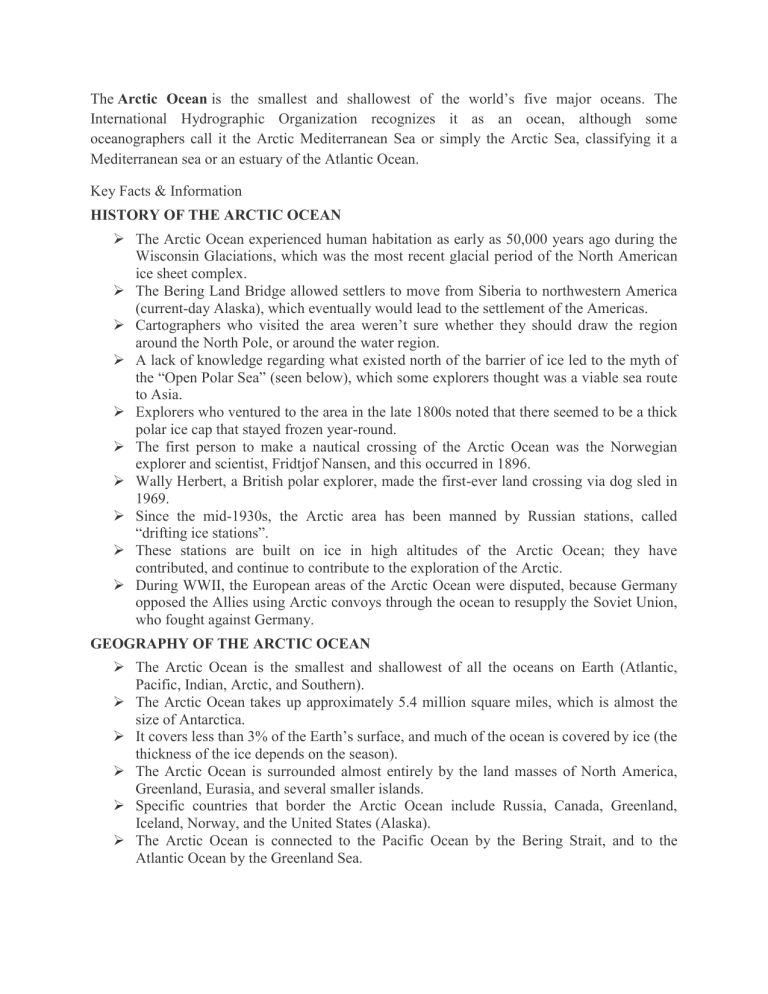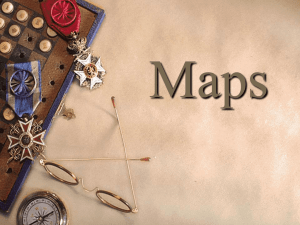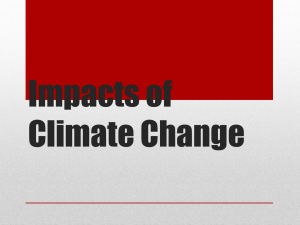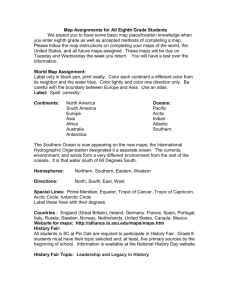Arctic Ocean: Facts, History, Geography & Environmental Concerns
advertisement

The Arctic Ocean is the smallest and shallowest of the world’s five major oceans. The International Hydrographic Organization recognizes it as an ocean, although some oceanographers call it the Arctic Mediterranean Sea or simply the Arctic Sea, classifying it a Mediterranean sea or an estuary of the Atlantic Ocean. Key Facts & Information HISTORY OF THE ARCTIC OCEAN The Arctic Ocean experienced human habitation as early as 50,000 years ago during the Wisconsin Glaciations, which was the most recent glacial period of the North American ice sheet complex. The Bering Land Bridge allowed settlers to move from Siberia to northwestern America (current-day Alaska), which eventually would lead to the settlement of the Americas. Cartographers who visited the area weren’t sure whether they should draw the region around the North Pole, or around the water region. A lack of knowledge regarding what existed north of the barrier of ice led to the myth of the “Open Polar Sea” (seen below), which some explorers thought was a viable sea route to Asia. Explorers who ventured to the area in the late 1800s noted that there seemed to be a thick polar ice cap that stayed frozen year-round. The first person to make a nautical crossing of the Arctic Ocean was the Norwegian explorer and scientist, Fridtjof Nansen, and this occurred in 1896. Wally Herbert, a British polar explorer, made the first-ever land crossing via dog sled in 1969. Since the mid-1930s, the Arctic area has been manned by Russian stations, called “drifting ice stations”. These stations are built on ice in high altitudes of the Arctic Ocean; they have contributed, and continue to contribute to the exploration of the Arctic. During WWII, the European areas of the Arctic Ocean were disputed, because Germany opposed the Allies using Arctic convoys through the ocean to resupply the Soviet Union, who fought against Germany. GEOGRAPHY OF THE ARCTIC OCEAN The Arctic Ocean is the smallest and shallowest of all the oceans on Earth (Atlantic, Pacific, Indian, Arctic, and Southern). The Arctic Ocean takes up approximately 5.4 million square miles, which is almost the size of Antarctica. It covers less than 3% of the Earth’s surface, and much of the ocean is covered by ice (the thickness of the ice depends on the season). The Arctic Ocean is surrounded almost entirely by the land masses of North America, Greenland, Eurasia, and several smaller islands. Specific countries that border the Arctic Ocean include Russia, Canada, Greenland, Iceland, Norway, and the United States (Alaska). The Arctic Ocean is connected to the Pacific Ocean by the Bering Strait, and to the Atlantic Ocean by the Greenland Sea. There are many underwater ridges and shelves in the Arctic Ocean; the largest underwater ridge (which is like an underwater mountain) is the Lomonosov Ridge, which divides the North Polar Basin into the Eurasian Basin and the Amerasian Basin. The average thickness of ice in the Arctic Ocean has been decreasing since 1980. Despite the reduction of ice, the ocean remains virtually icelocked from October to June each year. There are many endangered marine species living in the Arctic Ocean; these include walruses and whales. There are four species of whales living in the Arctic Ocean – the bowhead whale, grey whale, narwhal, and the beluga whale. Other animals that live in the Arctic Ocean and surrounding areas include polar bears and seals. There are six seal species living in the Arctic region – the bearded seal, ribbon seal, ringed seal, spotted seal, harp seal, and the hooded seal. ENVIRONMENTAL CONCERNS The Arctic Ocean and its surrounding area has a very fragile ecosystem. It is slow to change and very slow to recover from any amount of damage or disruption. The ice found in the Arctic is decreasing due to increased temperatures around the globe – this means a reduced habitat for animals such as seals and polar bears, which rely on the thick ice to serve as the platform on which they hunt for food. The Arctic Ocean is covered by an ice cap, but this too is decreasing in size due to global warming and pollution – there is a concern that if it continues to melt, there will be no more ice in the Arctic Ocean, which could happen by the year 2040. RANDOM FACTS ABOUT THE ARCTIC OCEAN The Arctic Ocean is home to more fish species than anywhere else in the world. There are three types of ice that cover the Arctic Ocean – polar ice, fast ice, and pack ice. When the ice in the Arctic Ocean melts, it releases valuable nutrients and organisms into the water which helps algae grow. An alga feeds zooplankton, which are important components of the food chain. The Arctic Ocean’s salinity is the lowest on average of the world’s major oceans due, in part, to heavy freshwater inflow from the various rivers and streams that empty into it. Several groups of indigenous people live in the Arctic region, including Inuit, Yupik, Aleut, and Saami people, who continue cultural traditions such as fishing and hunting. People can see the aurora borealis (also known as the northern lights) between November and April each year in the Arctic area.






